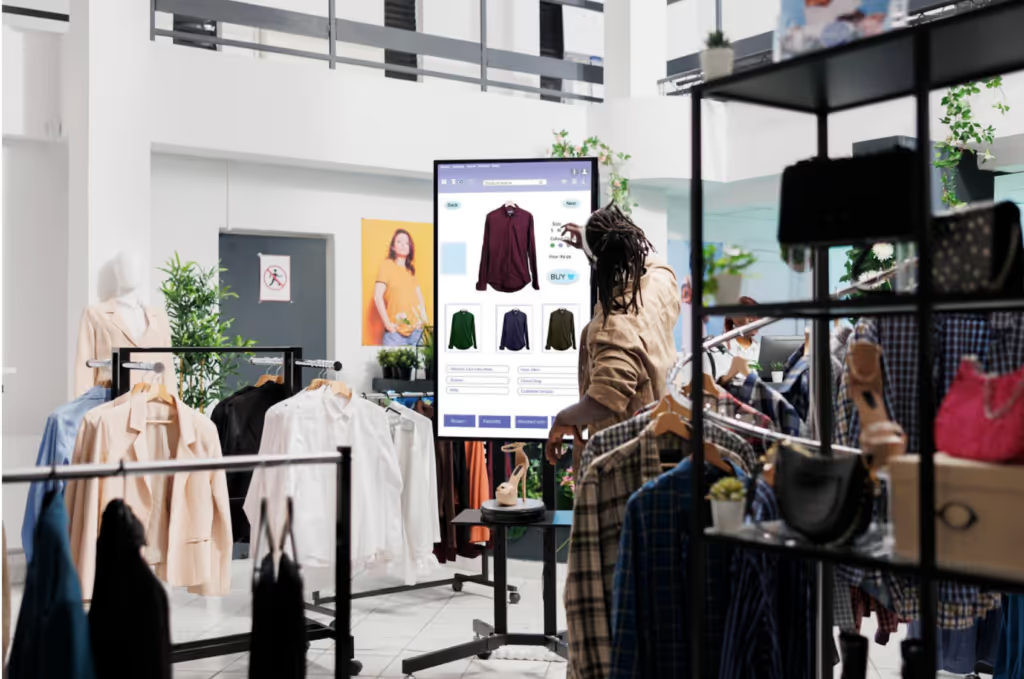The use of smart merchandising in elevating your ecommerce brand

Smart merchandising, a strategic approach to online retail, has emerged as a crucial tool for businesses looking to create immersive, personalized, and efficient shopping experiences. By leveraging this strategy, businesses can solve a number of challenges such as enhancing their customer experience, strengthening their brand's reputation, and cultivating revenue growth.
With global ecommerce sales expected to reach about 8.1 trillion dollars by 2026, it’s obvious that the world of ecommerce is only growing. However, to capitalize on this opportunity, businesses must strive to stand out from their competitors, and smart merchandising offers the means to achieve this.
In this guide, we delve deeper into the world of smart merchandising, discussing its key components, the role of visual merchandising in ecommerce, effective strategies for its implementation, online merchandising tips, and the critical part that technology plays in this innovative retail approach.

What is smart merchandising?
Smart merchandising is an innovative approach to online retail that employs advanced technologies and data-driven strategies to optimize the arrangement of products, collections, and promotions on an ecommerce website.
The term describes a data-backed method of managing an online store – from the display and organization of products to the implementation of AI-powered personalization tools. This dynamic approach allows businesses to leverage advanced strategies, AI technology, and customer data analytics to enhance the user experience and improve product discoverability and accessibility.

The ultimate objective is to improve conversion rates and boost sales by facilitating a smooth and engaging shopping journey for site visitors. It's an intricate system that includes several key elements, such as branding, imagery, inventory management, menu organization, product collections, and real-time user behavior analysis.
The core of smart merchandising lies in its application of data and user experience principles to transform casual browsers into paying customers. This transformation process includes various tactics, such as reminders for abandoned shopping carts, effective visual online merchandising, and well-placed calls to action to guide consumers through the purchase process.
Key components of smart merchandising
Smart merchandising uses emerging technologies and data-driven techniques to strategically position and promote products on an ecommerce platform. Here are the key components of it.
AI-powered product tagging and assortment
Using AI, retailers can tag products with relevant information and categorize them accordingly, facilitating easier product discovery for customers. This also allows selective showcasing via product assortment, where certain products can be emphasized based on their relevance or popularity.
Design and UX considerations
Smart merchandising takes into account the importance of design and user experience (UX) in creating a seamless shopping customer journey. This includes the design of the website, its navigation system, and the organization of its product catalog, among other features.
Data-driven strategies
Smart merchandising relies heavily on data to guide its strategies. This includes using real-time data insights to cross-sell products from different niches, which can increase the value of customers' shopping carts. It also involves using data to offer hyper-personalized shopping experiences, with relevant recommendations, visual online merchandising, dynamic collections, and thematic galleries.
Inventory management
Using inventory data to inform various strategies, such as stock replenishment and product campaigns, smart merchandising ensures that the most popular or relevant products are always available for customers to purchase.
AI and machine learning
This tactic leverages AI and machine learning to understand and predict customer behavior and optimize the user experience based on different audience segments. AI also aids in the creation of dynamic product groups based on attributes, providing more contextual signals for algorithms.
Effective search and navigation
Smart navigation with dynamic filtering helps customers find their desired products quickly and effortlessly, enhancing their shopping experience. Some solutions employ built-in Natural Language Understanding (NLU) to better understand shoppers' queries, even when they include variations in phrasing or typos, thereby delivering more accurate and relevant search results.

Visual merchandising ecommerce
Visual merchandising in ecommerce involves the strategic display and organization of products in an online store, akin to a digital shop window. It aims to create an aesthetically pleasing and engaging user interface that stimulates customer purchasing decisions, boosts sales, enhances customer loyalty, and increases average order value.

What follows are visual merchandising ecommerce key aspects.
Product imagery
Clear and detailed product photos from multiple angles help customers understand the product and make informed purchasing decisions. Consistent image sizes and styles across the website create a cohesive and professional look.
Product presentation
How products are presented on the website significantly impacts customer engagement. This includes arranging products in logical categories, using clear and descriptive product titles, and organizing them in a visually pleasing manner. Grouping related items, showcasing best-sellers or new arrivals, and using product badges or labels can help highlight specific products or promotions.
Visual hierarchy
Establishing a clear visual hierarchy guides customers' attention and makes it easier for them to navigate and find desired products. This involves using size, color, contrast, and positioning to prioritize important elements such as product images, prices, and call-to-action buttons.
Color and branding
Consistent use of colors and branding elements throughout the website helps reinforce brand identity and recognition. Colors should be carefully chosen to evoke desired emotions, reflect the brand personality, and create a visually pleasing experience.
Responsive design
Ecommerce merchandising should account for responsive design, ensuring that the website and product displays are optimized for various devices, such as desktops, tablets, and mobile phones. The layout should adapt seamlessly to different screen sizes, maintaining the visual appeal and functionality across devices.
Virtual try-on and 360-degree views
Incorporating virtual try-on features or 360-degree product views can enhance the online shopping experience, particularly for fashion or home decor items. These interactive elements allow customers to visualize how products will look or fit, increasing confidence and reducing returns.
Personalization and recommendations
By leveraging customer data and algorithms, personalized product recommendations can be displayed to customers based on their browsing and purchasing history. This tailors the shopping experience, increases relevance, and encourages additional sales.
Visual storytelling
Using visuals to tell a compelling brand or product story can engage customers on an emotional level. This can include lifestyle imagery, videos, or customer testimonials that convey the benefits, features, or unique selling points of the products.
Effective smart merchandising strategies
Smart merchandising, whether employed in brick-and-mortar or ecommerce settings, aims to captivate customer attention, influence their purchasing decisions, and enhance their overall shopping experience.
Below are some effective strategies that ecommerce businesses can employ.
Data-driven solutions
With the rise of big data and analytics, retailers have unprecedented access to customer behavior and preferences. By leveraging these insights, businesses can better position their products, pricing, and promotions to align with customer needs and preferences.
Visual appeal
The use of appealing visual elements in product displays can strongly influence customer behavior. Retailers can strategically place products, use appealing colors and imagery, and create themed displays to catch customer attention.
Performance-based metrics
Ecommerce businesses should use performance-based metrics such as availability and compliance to track the effectiveness of their merchandising strategies. This helps them continually refine their approach based on the strategies that yield the best results.
Dynamic merchandising
Merchandising strategies should be flexible and adaptable to meet changing consumer needs and market conditions. This includes modifying displays to highlight seasonal items, new products, or current market trends.
Specialized merchandising strategies
Strategies can range from traffic building to transaction building, profit-generating, turf defending, excitement generating, and image enhancing. These include placing high loyalty items in visible places to build traffic, creating excitement around new or seasonal products, or enhancing the store's image by promoting sustainable or local products.
Personalized recommendations
Using algorithms to suggest relevant products based on individual browsing patterns and purchase history can lead to increased sales.
User-generated content
Incorporating UGC, like customer reviews and images, can help build credibility, authenticity, and trust, enhancing the overall shopping experience of your potential customers.
Optimized site navigation
For online stores, easy and intuitive site navigation with search functionality makes it easier for customers to find and buy products.
The Role of technology in smart merchandising
Technology plays a pivotal role in transforming traditional merchandising practices into smart merchandising, enabling retailers to respond more effectively to changing market dynamics and consumer expectations.
Analytics and predictive modelling
Today's retailers use analytics to make data-driven decisions. Traditional merchandising, which relied heavily on instinct and past experience, is giving way to more sophisticated and forward-looking approaches.
Analytics provides insights into shopping patterns, consumer preferences, and product performance, which can drive strategic decisions. Predictive modeling, enabled by machine learning, allows retailers to forecast future trends and adjust their strategies accordingly.
Automation
Smart merchandising leverages automation to expedite and optimize merchandising processes. This includes the use of smart planograms that automatically organize product displays, tools for rapid price updates, and automated reordering systems. By reducing manual tasks, merchants can focus more on strategic responsibilities and decision-making.
Artificial intelligence
AI offers significant opportunities for smart merchandising, from enhancing demand prediction to personalizing customer experiences. It can support segmentation and attribute management and can also dynamically group products into solution families based on customer preferences and needs. Recommendation engines powered by AI algorithms can offer customers personalized product suggestions based on their browsing history and purchasing patterns.
Digital enablement
Digital transformation enables retailers to integrate their online and offline operations, creating seamless omnichannel customer experiences. Advanced systems and tools allow for real-time inventory visibility, personalized marketing, and agile response to market changes. This digital enablement also demands a shift in the workforce, requiring talents who are comfortable with digital tools, analytics, and a customer-centric mindset.

Be smart and ace your online merchandising game!
The rise of ecommerce has fundamentally reshaped the global retail landscape, driven by technological advances and changing consumer behaviors. It's a sector that has seen dramatic growth, with the onset of the Covid-19 pandemic accelerating this trend. As more consumers embrace the convenience of online shopping, businesses are continually seeking innovative strategies to engage with their customer base and foster brand loyalty.
Smart merchandising provides a powerful platform for businesses to enhance their ecommerce brand. By leveraging data analytics, AI technology, and personalized, visually engaging content, businesses can deliver experiences that captivate customers, encourages engagement, and drives higher sales. So, leverage smart merchandising tools today and watch your ecommerce sales go up north and to the right!




